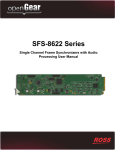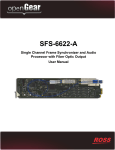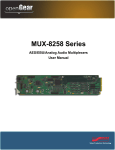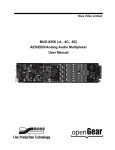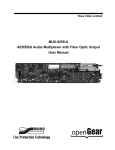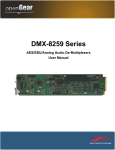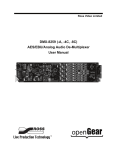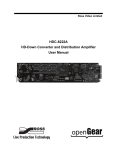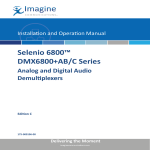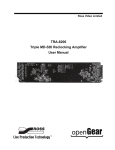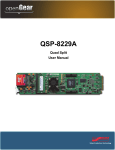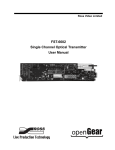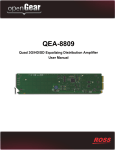Download SFS-8622-A User Manual
Transcript
SFS-8622-A Single Channel Frame Synchronizer with Audio Processing User Manual Thank you for choosing Ross You've made a great choice. We expect you will be very happy with your purchase of Ross Technology. Our mission is to: 1. Provide a Superior Customer Experience • offer the best product quality and support 2. Make Cool Practical Technology • develop great products that customers love Ross has become well known for the Ross Video Code of Ethics. It guides our interactions and empowers our employees. I hope you enjoy reading it below. If anything at all with your Ross experience does not live up to your expectations be sure to reach out to us at [email protected]. David Ross CEO, Ross Video [email protected] Ross Video Code of Ethics Any company is the sum total of the people that make things happen. At Ross, our employees are a special group. Our employees truly care about doing a great job and delivering a high quality customer experience every day. This code of ethics hangs on the wall of all Ross Video locations to guide our behavior: 1. We will always act in our customers’ best interest. 2. We will do our best to understand our customers’ requirements. 3. We will not ship crap. 4. We will be great to work with. 5. We will do something extra for our customers, as an apology, when something big goes wrong and it's our fault. 6. We will keep our promises. 7. We will treat the competition with respect. 8. We will cooperate with and help other friendly companies. 9. We will go above and beyond in times of crisis. If there's no one to authorize the required action in times of company or customer crisis - do what you know in your heart is right. (You may rent helicopters if necessary.) SFS-8622-A User Manual • Ross Part Number: 8622DR-004-01 • Release Date: July 9, 2014. Copyright © 2014 Ross Video Limited. Ross®, openGear®, and any related marks are trademarks or registered trademarks of Ross Video Ltd. All other trademarks are the property of their respective companies. PATENTS ISSUED and PENDING. All rights reserved. No part of this publication may be reproduced, stored in a retrieval system, or transmitted in any form or by any means, mechanical, photocopying, recording or otherwise, without the prior written permission of Ross Video. While every precaution has been taken in the preparation of this document, Ross Video assumes no responsibility for errors or omissions. Neither is any liability assumed for damages resulting from the use of the information contained herein. Patents Patent numbers 4,205,346; 5,115,314; 5,280,346; 5,561,404; 7,034,886; 7,508,455; 7,602,446; 7,834,886; 7,914,332; 8,499,019 B2; 2039277; 1237518; 1127289 and other patents pending. Important Regulatory and Safety Notices to Service Personnel Before using this product and nay associated equipment, refer to the “Important Safety Instructions” listed below to avoid personnel injury and to prevent product damage. Product may require specific equipment, and/or installation procedures to be carried out to satisfy certain regulatory compliance requirements. Notices have been included in this publication to call attention to these specific requirements. Symbol Meanings This symbol on the equipment refers you to important operating and maintenance (servicing) instructions within the Product Manual Documentation. Failure to heed this information may present a major risk of damage to persons or equipment. Warning — The symbol with the word “Warning” within the equipment manual indicates a potentially hazardous situation, which, if not avoided, could result in death or serious injury. Caution — The symbol with the word “Caution” within the equipment manual indicates a potentially hazardous situation, which, if not avoided, may result in minor or moderate injury. It may also be used to alert against unsafe practices. Notice — The symbol with the word “Notice” within the equipment manual indicates a potentially hazardous situation, which, if not avoided, may result in major or minor equipment damage or a situation which could place the equipment in a non-compliant operating state. ESD Susceptibility — This symbol is used to alert the user that an electrical or electronic device or assembly is susceptible to damage from an ESD event. Important Safety Instructions Caution — This product is intended to be a component product of the DFR-8321 and OG3-FR series frame. Refer to the DFR-8300 and OG3-FR Series Frame User Manual for important safety instructions regarding the proper installation and safe operation of the frame as well as its component products. Warning — Certain parts of this equipment namely the power supply area still present a safety hazard, with the power switch in the OFF position. To avoid electrical shock, disconnect all A/C power cords from the chassis’ rear appliance connectors before servicing this area. Warning — Service barriers within this product are intended to protect the operator and service personnel from hazardous voltages. For continued safety, replace all barriers after any servicing. This product contains safety critical parts, which if incorrectly replaced may present a risk of fire or electrical shock. Components contained with the product’s power supplies and power supply area, are not intended to be customer serviced and should be returned to the factory for repair. To reduce the risk of fire, replacement fuses must be the same time and rating. Only use attachments/accessories specified by the manufacturer. EMC Notices United States of America FCC Part 15 This equipment has been tested and found to comply with the limits for a class A Digital device, pursuant to part 15 of the FCC Rules. These limits are designed to provide reasonable protection against harmful interference when the equipment is operated in a commercial environment. This equipment generates, uses, and can radiate radio frequency energy and, if not installed and used in accordance with the instruction manual, may cause harmful interference to radio communications. Operation of this equipment in a residential area is likely to cause harmful interference in which case the user will be required to correct the interference at their own expense. Notice — Changes or modifications to this equipment not expressly approved by Ross Video Limited could void the user’s authority to operate this equipment. CANADA This Class “A” digital apparatus complies with Canadian ICES-003. Cet appariel numerique de la classe “A” est conforme a la norme NMB-003 du Canada. EUROPE This equipment is in compliance with the essential requirements and other relevant provisions of CE Directive 93/68/EEC. INTERNATIONAL This equipment has been tested to CISPR 22:1997 along with amendments A1:2000 and A2:2002, and found to comply with the limits for a Class A Digital device. Notice — This is a Class A product. In domestic environments, this product may cause radio interference, in which case the user may have to take adequate measures. Maintenance/User Serviceable Parts Routine maintenance to this openGear product is not required. This product contains no user serviceable parts. If the module does not appear to be working properly, please contact Technical Support using the numbers listed under the “Contact Us” section on the last page of this manual. All openGear products are covered by a generous 5-year warranty and will be repaired without charge for materials or labor within this period. See the “Warranty and Repair Policy” section in this manual for details. Environmental Information The equipment that you purchased required the extraction and use of natural resources for its production. It may contain hazardous substances that could impact health and the environment. To avoid the potential release of those substances into the environment and to diminish the need for the extraction of natural resources, Ross Video encourages you to use the appropriate take-back systems. These systems will reuse or recycle most of the materials from your end-of-life equipment in an environmentally friendly and health conscious manner. The crossed out wheelie bin symbol invites you to use these systems. If you need more information on the collection, re-use, and recycling systems, please contact your local or regional waste administration. You can also contact Ross Video for more information on the environmental performance of our products. Company Address Ross Video Limited Ross Video Incorporated 8 John Street P.O. Box 880 Iroquois, Ontario, K0E 1K0 Ogdensburg, New York Canada USA 13669-0880 General Business Office: (+1) 613 • 652 • 4886 Fax: (+1) 613 • 652 • 4425 Technical Support: (+1) 613 • 652 • 4886 After Hours Emergency: (+1) 613 • 349 • 0006 E-mail (Technical Support): [email protected] E-mail (General Information): [email protected] Website: http://www.rossvideo.com Contents Introduction 1 Overview.............................................................................................................................. 1-2 Features.................................................................................................................. 1-2 Functional Block Diagrams ................................................................................................. 1-4 Frame Synchronizer Overview ............................................................................................ 1-5 User Interfaces ..................................................................................................................... 1-6 DashBoard Control System ................................................................................... 1-6 Card-edge Monitoring ........................................................................................... 1-6 SNMP Monitoring and Control ............................................................................. 1-6 Documentation Terms and Conventions.............................................................................. 1-7 Installation 2 Before You Begin ................................................................................................................ 2-2 Static Discharge..................................................................................................... 2-2 Unpacking.............................................................................................................. 2-2 Installing a Card................................................................................................................... 2-3 Supported Rear Modules ....................................................................................... 2-3 Installing a Rear Module ....................................................................................... 2-3 Installing the Card ................................................................................................. 2-4 SFS-8622-A Cabling Overview........................................................................................... 2-5 Using DashBoard ................................................................................................................. 2-6 Software Upgrades............................................................................................................... 2-7 Video Setup 3 Before You Begin ................................................................................................................ 3-2 Selecting a Reference Source .............................................................................................. 3-3 Frame Rate Compatibility ..................................................................................... 3-3 Selecting a Reference Source ................................................................................ 3-3 Adding a Delay .................................................................................................................... 3-5 Adjusting with Video Proc Amps ........................................................................................ 3-6 ANC Processing................................................................................................................... 3-7 HANC Processing ................................................................................................. 3-7 VANC Processing ................................................................................................. 3-7 Additional Setup .................................................................................................................. 3-9 Loss of Input.......................................................................................................... 3-9 Audio Setup 4 Selecting an AES Configuration.......................................................................................... 4-2 Configuring the AES Inputs ................................................................................................ 4-4 Configuring the AES Outputs.............................................................................................. 4-5 Embedded Outputs............................................................................................................... 4-7 Setting up Embedded Outputs ............................................................................... 4-7 Configuring the Embedded Output Groups........................................................... 4-8 Embedding PCM and Non-PCM Signals .......................................................................... 4-10 SFS-8622-A User Manual (Iss. 01) Contents • i Embedding PCM Signals..................................................................................... 4-10 Embedding Non-PCM Signals ............................................................................ 4-10 Card-edge Monitoring 5 Card Overview ..................................................................................................................... 5-2 Control and Monitoring Features ......................................................................................... 5-3 Status and Selection LEDs..................................................................................... 5-3 DashBoard Menus 6 Status Tabs ........................................................................................................................... 6-2 Signal Tab .............................................................................................................. 6-2 Hardware Tab ........................................................................................................ 6-4 Product Tab............................................................................................................ 6-4 Setup Tab ............................................................................................................................. 6-5 Proc Amp Tab ...................................................................................................................... 6-8 VANC Processing Tab ......................................................................................................... 6-9 Input Status Tab ................................................................................................................. 6-10 Embedded Outputs Tab...................................................................................................... 6-11 AES Inputs Tabs ................................................................................................................ 6-12 AES Outputs Tabs.............................................................................................................. 6-13 Alarm Enables Tab............................................................................................................. 6-14 Specifications 7 Technical Specifications ...................................................................................................... 7-2 SDI Input ............................................................................................................... 7-2 SDI Outputs ........................................................................................................... 7-2 AES Outputs .......................................................................................................... 7-3 Environmental and Power Consumption ............................................................... 7-3 Channel Status Data Table ................................................................................................... 7-4 Passing the Status Bytes ........................................................................................ 7-4 Service Information 8 Troubleshooting Checklist ................................................................................................... 8-2 Bootload Button..................................................................................................... 8-2 Warranty and Repair Policy ................................................................................................. 8-3 ii • Contents SFS-8622-A User Manual (Iss. 01) Introduction In This Chapter This chapter contains the following sections: • Overview • Functional Block Diagrams • Frame Synchronizer Overview • User Interfaces • Documentation Terms and Conventions A Word of Thanks Congratulations on choosing an openGear SFS-8622-A Single Channel Frame Synchronizer with Audio Processing. Your card is part of a full line of products within the openGear Terminal Equipment family of products, backed by Ross Video's experience in engineering and design expertise since 1974. You will be pleased at how easily your new card fits into your overall working environment. Equally pleasing is the product quality, reliability and functionality. Thank you for joining the group of worldwide satisfied Ross Video customers! Should you have a question pertaining to the installation or operation of your card, please contact us at the numbers listed on the back cover of this manual. Our technical support staff is always available for consultation, training, or service. SFS-8622-A User Manual (Iss. 01) Introduction • 1–1 Overview Each card is a single channel SD/HD/3G SDI frame synchronizer that automatically detects the incoming video format. Each card accepts an SDI signal of either 270Mbps, 1.485Gbps, or 2.987Gbps, automatically equalizing for cable loss and providing two processed SDI outputs. The video is synchronized to either a frame-wide reference or a local reference. You can also resolve system timing problems as an additional fixed delay can be added to the video and/or audio. Each card is also a high quality program AES multiplexer/de-multiplexer capable of embedding/de-embedding up to six AES/EBU pairs (twelve audio channels) into an SDI signal. Audio proc control on each output allows for audio processing with independent channel Sample Rate Conversion (SRC) on each AES input, gain of +/-20dB, audio delay up to 1 second and channel phase invert and summing capability. If the input is a synchronous 48kHz signal, the audio can be embedded into the SDI signal unaltered. If the input is not a synchronous 48kHz signal, it may be converted using SRC before it is embedded on the SDI output. Table 1.1 summarizes how each card model can be configured in DashBoard. Card Model SFS-8622-A Table 1.1 Configuration Options Mode 1 Mode 2 6 x AES-3id 75ohm unbalanced inputs 6 x AES-3id 75ohm unbalanced outputs Mode 3 3 x AES-3id 75ohm unbalanced inputs, 3 x AES-3id 75ohm unbalanced outputs Features The following features are available: • Supports SMPTE 259M (270Mbps), SMPTE 292M (1.485Gbps), and SMPTE 424M (2.987Gbps) • Supports embedding of non-PCM data such as Dolby® Digital and Dolby® E • Two SDI processed outputs1 • Video proc amp on output video • Six configurable AES connections (can be configured as inputs or outputs) • Support for up to 28 frames of video delay • Support for different reference format locking (frame rates must match) • Programmable video output on SDI input loss • Automatic input video format detection • Ability to strip VANC data from specific or all lines of a video output • No HANC or VANC processing (pass through the Frame Sync) • Audio embedding for all popular formats: 480i, 576i, 720p, 1080i, and 1080p (Level A) • Full control over channel assignments • Audio proc controls such as gain, invert, delay and sum on embedded outputs and AES outputs • Internally generated test patterns and test tones • Programmable silence detection and timeout thresholds 1. When the card is passing live video, embedded audio and other ancillary data are passed through. 1–2 • Introduction SFS-8622-A User Manual (Iss. 01) • Automatic audio delay to match video delay in addition to up to 1 second of user adjusted audio delay • Reports status and configuration remotely via the DashBoard Control System • SNMP support available • Fits openGear frames • 5-year transferable warranty SFS-8622-A User Manual (Iss. 01) Introduction • 1–3 Functional Block Diagrams This section provides functional block diagrams that outline the work flow of the SFS-8622-A. FRAME REF IN FRAME SYNC SDI VIDEO IN (BNC 1) PROC AMP TEST PATTERN AUDIO EMBED SDI VIDEO OUT 1 (BNC 2) SDI TRANSMITTER SDI VIDEO OUT 2 (BNC 3) SDI RECEIVER 16 CHANNEL DMX WITH SRC 16 CHANNELS 16 CHANNELS AES INPUTS SAMPLE RATE CONVERTER 12 CHANNELS AUDIO PROC & TONE GENERATOR Up to 12 CHANNELS Figure 1.1 SFS-8622-A — Six Unbalanced AES Inputs FRAME REF IN FRAME SYNC SDI VIDEO IN (BNC 1) PROC AMP TEST PATTERN AUDIO EMBED SDI VIDEO OUT 1 (BNC 2) SDI TRANSMITTER SDI VIDEO OUT 2 (BNC 3) SDI RECEIVER 16 CHANNELS 16 CHANNEL DMX WITH SRC 16 CHANNELS AES OUTPUTS 12 CHANNELS AUDIO PROC & TONE GENERATOR Up to 16 CHANNELS Figure 1.2 SFS-8622-A — Six Unbalanced AES Outputs FRAME REF IN FRAME SYNC SDI VIDEO IN (BNC 1) PROC AMP TEST PATTERN AUDIO EMBED SDI TRANSMITTER SDI RECEIVER 16 CHANNEL DMX WITH SRC 16 CHANNELS SDI VIDEO OUT 1 (BNC 2) SDI VIDEO OUT 2 (BNC 3) 16 CHANNELS AES OUTPUTS AES INPUTS SAMPLE RATE CONVERTER 6 CHANNELS AUDIO PROC & TONE GENERATOR Up to 6 CHANNELS Up to 6 CHANNELS Figure 1.3 SFS-8622-A — Three Unbalanced AES Inputs, Three Unbalanced AES Outputs 1–4 • Introduction SFS-8622-A User Manual (Iss. 01) Frame Synchronizer Overview Each card will typically be used in a broadcast studio for one or both of the following functions: • Frame delay for timing alignment • Frame synchronizer for frame rate conversion Figure 1.4 illustrates the operation of your card Frame N Frame N+1 Frame N+F Frame N+2 Frame N+1+F Frame N+2+F Figure 1.4 Functional Overview The following elements are presented in Figure 1.4: 1. Up Arrow Represents the start of a video frame. 2. Selected Reference The selected reference can be on of the following: either analog reference from the openGear frame, or the digital reference extracted from the SDI video input. Note that when selecting the digital reference from the SDI input, Figure 1.4 should be re-drawn with the Up Arrows of the Selected Reference and Video Input aligned vertically. 3. Video Input The SDI video input is derived from the rear module. When the video input is not locked to the selected reference, the video input start of frame will drift compared to the reference. This can be visualized by sliding the Up Arrows of Figure 1.4 to the left if the video input frame rate is slower than the reference, or to the right if it is higher. 4. Video Output The processed SDI video outputs are available on the rear module.The video output timing is always locked to the selected reference. The card allows the user to set the relative position of the video output start of frame as an offset to the reference. With the adjustable Vertical and Horizontal Delay settings, you can set the relative offset anywhere in the reference frame timing, in increments of 1 line for vertical timing and 1 pixel for horizontal timing. 5. Delay (F, V, H) The value F represents the number of frame of delay that can be adjusted, the value V the number of lines, and the value H the number of pixels of delay. The delay values can be adjust from 1 (default) to a maximum limit of 28. SFS-8622-A User Manual (Iss. 01) Introduction • 1–5 User Interfaces Your card includes three control and monitoring interfaces. DashBoard Control System The DashBoard Control System enables you to monitor and control openGear frames and cards from a computer. DashBoard communicates with other cards in the frame through the Network Controller Card. The DashBoard Control System software and manual are available for download from our website. For More Information on... • the menus in DashBoard, refer to the chapter “DashBoard Menus” on page 6-1. • using DashBoard, refer to the DashBoard User Manual. Card-edge Monitoring The front-edge of each card features LED indicators for the power, and video reference input status. For More Information on... • the card-edge monitoring features, refer to the section “Control and Monitoring Features” on page 5-3. SNMP Monitoring and Control The Network Controller Card in the openGear frame can provide optional support for remote monitoring of your frame and using Simple Network Management Protocol (SNMP), which is compatible with many third-party monitoring and control tools. For More Information on... 1–6 • Introduction • enabling SNMP Monitoring and Control for your frame, refer to the MFC-8300 Series User Manual. • SNMP controls for the SFS-8622-A, refer to the Management Information Base (MIB) for your card model. SFS-8622-A User Manual (Iss. 01) Documentation Terms and Conventions The following terms and conventions are used throughout this manual. Terms The following terms are used: • “Board”, and “Card” refer to the SFS-8622-A unless otherwise noted. • “DFR-8321 series” refers to DFR-8321 series frames and any available options. • “Frame” refers to the openGear frame that houses the card. • “OG3-FR series” refers to all versions of the OG3-FR series frames and any available options. • “openGear frame” also includes all version of the DFR-8321 series and OG3-FR series frames and any available options unless otherwise noted. • “Operator” and “User” refer to the person who uses the card. • “PAL” refers to PAL-B, and PAL-G unless otherwise noted. • “PCM” refers to Pulse Code Modulation. • “SRC” refers to Sample Rate Conversion. • “System” and “Video system” refer to the mix of interconnected production and terminal equipment in your environment. Conventions The following conventions are used: • “Operating Tips” and “Note” boxes are used to provide additional user information. SFS-8622-A User Manual (Iss. 01) Introduction • 1–7 1–8 • Introduction SFS-8622-A User Manual (Iss. 01) Installation In This Chapter This chapter provides instructions for installing a rear module, installing a card into an openGear frame, cabling details, and updating the card software. The following topics are discussed: • Before You Begin • Installing a Card • SFS-8622-A Cabling Overview • Using DashBoard • Software Upgrades SFS-8622-A User Manual (Iss. 01) Installation • 2–1 Before You Begin Before proceeding with the instructions in this chapter, ensure that your openGear frame is properly installed according to the instructions in its manual. Static Discharge Throughout this chapter, please heed the following cautionary note: ESD Susceptibility — Static discharge can cause serious damage to sensitive semiconductor devices. Avoid handling circuit boards in high static environments such as carpeted areas and when synthetic fiber clothing is worn. Always exercise proper grounding precautions when working on circuit boards and related equipment. Unpacking Unpack each SFS-8622-A you received from the shipping container and ensure that all items are included. If any items are missing or damaged, contact your sales representative or Ross Video directly. 2–2 • Installation SFS-8622-A User Manual (Iss. 01) Installing a Card This section outlines how to install a rear module and card in an openGear frame. Note — The SFS-8622-A cards are not supported in the DFR-8310 series frames. Supported Rear Modules The 8320AR-041 Full Rear Module is required when installing the SFS-8622-A. Installing a Rear Module If the Rear Module is already installed, proceed to the section “Installing the Card” on page 2-4. To install a rear module in your openGear frame 1. Locate the card frame slots on the rear of the frame. 2. Remove the Blank Plate from the slot you have chosen for the card installation. 3. Install the bottom of the Rear Module in the Module Seating Slot at the base of the frame’s back plane. Figure 2.1 Screw Hole Module Seating Slots Figure 2.1 Rear Module Installation in an openGear Frame (Card not shown) 4. Align the top hole of the Rear Module with the screw on the top-edge of the frame back plane. 5. Using a Phillips screwdriver and the supplied screw, fasten the Rear Module to the back plane of the frame. Do not over tighten. 6. Ensure proper frame cooling and ventilation by having all rear frame slots covered with Rear Modules or Blank Plates. SFS-8622-A User Manual (Iss. 01) Installation • 2–3 Installing the Card This section outlines how to install a card in an openGear frame. If the card is to be installed in any compatible frame other than a Ross Video product, refer to the frame manufacturer’s manual for specific instructions. To install the card in an openGear frame 1. Locate the Rear Module you installed in the procedure “Installing a Rear Module” on page 2-3. 2. Hold the card by the edges and carefully align the card-edges with the slots in the frame. 3. Fully insert the card into the frame until the rear connection plus is properly seated in the Rear Module. 4. Verify whether your Rear Module Label is self-adhesive by checking the back of the label for a thin wax sheet. You must remove the wax sheet before affixing the label. 5. Affix the supplied Rear Module Label to the BNC area of the Rear Module. 2–4 • Installation SFS-8622-A User Manual (Iss. 01) SFS-8622-A Cabling Overview The synchronous AES audio input streams at 48kHz or any asynchronous AES streams from 32kHz to 96kHz with SRC enabled. Note that SRC should only be used with Pulse Code Modulation (PCM) digital audio and not any form of compressed signal, such as Dolby®. Note — AES inputs and outputs are configured in groups of three. Figure 2.2 illustrates the cabling designations for one SDI input, two SDI outputs, and six unbalanced AES inputs. Figure 2.3 illustrates the cabling designations for one SDI input, two SDI outputs, and six AES-3id 75ohm unbalanced outputs. SDI In SDI Out 1 SDI In SDI Out 1 SDI Out 2 Not Used SDI Out 2 Not Used AES In 1 AES In 4 AES Out 1 AES Out 4 AES In 2 AES In 5 AES Out 2 AES Out 5 AES In 3 AES In 6 AES Out 3 AES Out 6 Figure 2.2 Cable Connections for the SFS-8622-A Figure 2.3 Cable Connections for the SFS-8622-A Figure 2.4 illustrates the cabling designations for one SDI input, two SDI outputs, three AES-3id 75ohm unbalanced inputs, and three AES-3id 75ohm unbalanced outputs. SDI In SDI Out 1 SDI Out 2 Not Used AES In 1 AES Out 1 AES In 2 AES Out 2 AES In 3 AES Out 3 Figure 2.4 Cable Connections for the SFS-8622-A SFS-8622-A User Manual (Iss. 01) Installation • 2–5 Using DashBoard Before proceeding, ensure that the DashBoard is installed on a computer connected to your facility network. The DashBoard software and user manual are available from the Ross Video website. For More Information on... • using DashBoard, refer to the DashBoard User Manual. To launch DashBoard 1. Ensure that you are running DashBoard software version 6.1.0 or higher. 2. Launch DashBoard by double-clicking its icon on your desktop. 3. Ensure that the openGear frame with your card is displayed in the Tree View located on the left-side of the DashBoard window. It may take 30 seconds or more to update the Tree View. Consult the MFC-8300 Series User Manual and DashBoard User Manual should the Tree View not display your card. To access a card in DashBoard 1. From the Tree View, expand the node for the openGear frame your cards are installed in. A list of cards installed in the frame is now displayed. In the example below, the node for Frame 5 is expanded to show a list of six cards including an SFS-8622-A. 2. Double-click the node for a card to display its menus in the Device View of DashBoard (right-side of the DashBoard window). Example of an SFS-8622-A in DashBoard 2–6 • Installation SFS-8622-A User Manual (Iss. 01) Software Upgrades This section provides instructions for upgrading the software for your card using the DashBoard Control System. To upload software to the card 1. Contact Ross Technical Support for the latest software version file. 2. In DashBoard, double-click the card its status indicator in the Basic Tree View. 3. From the Device tab, click Upload to display the Select File for upload dialog box. 4. Navigate to the *.bin upload file you wish to upload. DashBoard automatically selects the last directory that you loaded from. 5. Click Open to display a confirmation dialog box. This dialog box displays the selected upload file name, type, size, and the file creation date. 6. From the Confirmation dialog box, select one of the following: • Cancel — Select this option to cancel the upload of the file and return to the Device View. • Continue — Select this option to upload the file. While uploading, an Uploading Progress dialog box opens. Notice — Clicking the Cancel button while uploading will leave the card in an invalid state. Do not click Cancel unless the uploading progress has stopped completely for 60 seconds or more. If upload fails, repeat the upload process from DashBoard. If the upload process fails again, refer to the section “Bootload Button” on page 8-2. 7. Monitor the upgrade progress bar displayed in DashBoard while the software is upgraded on your card. 8. To complete the upgrade process, you must reboot the card as follows: • From the Device tab, click Reboot to reboot card. The reboot process takes up to 30 seconds. Note — The communications processor of the card requires approximately 30 seconds to re-start and re-establish network communications. • The card automatically saves all your settings before starting the reboot process. • The status of all the cards in the frame are grayed out until the reboot process is complete. SFS-8622-A User Manual (Iss. 01) Installation • 2–7 2–8 • Installation SFS-8622-A User Manual (Iss. 01) Video Setup In This Chapter This chapter provides a general overview of the user controls available on your card. The following topics are discussed: • Before You Begin • Selecting a Reference Source • Adding a Delay • Adjusting with Video Proc Amps • ANC Processing • Additional Setup SFS-8622-A User Manual (Iss. 01) Video Setup • 3–1 Before You Begin Each card provides a valid video output frame with formatted TRS codes. In certain conditions, however, the video output of the card will have to be re-synchronized and while doing so, the card will not be able to maintain a valid output. The following conditions will force a re-sync of the video output of the card: • Reference loss and reference re-acquired — To provide a stable output, the card must have a stable reference. • Changes in the vertical (V) or horizontal (H) delay parameters — A parameter change will force the SFS output to reset and restart the video output with the specified V/H offset. Note that changing the number of frames (F) of delay will not reset the output as long as the V/H parameters are constant. • Video input format change — The card will auto-detect the video input format and if it is recognized as one of its supported formats, it will set its output to match it. While doing so, the output will be reset and re-started. When the video input signal is locked to the selected external reference, the card will operate in Frame Delay mode. In this mode of operation, card will not be adding or dropping any frames. It is important to understand that when the card is using the digital reference extracted from the SDI video input, the SDI video input signal must be stable at all times. Any glitches on this signal will likely cause the card video output to stop and restart, basically re-syncing the video output to the digital reference. Therefore, in practical applications, it will not be possible to switch the SDI video input from an upstream router without re-syncing the card video output. For this reason, it is strongly recommended not to use the SDI input as the reference, and to select instead one of the analog references. If the SDI video input signal happens to be locked to the selected analog reference, the card will be effectively operating in frame delay mode, as no frames drop/repeat will be occurring. 3–2 • Video Setup SFS-8622-A User Manual (Iss. 01) Selecting a Reference Source The openGear frames support a distributed frame reference, allowing incoming reference signals to feed timing information to all cards in that frame. Thus, a single signal can be used for multiple cards. Alternatively, each card accepts a reference signal on the rear module to provide additional system timing flexibility. Frame Rate Compatibility Refer to Table 3.1 for frame rate compatibility. Note that 720p, 1080i 60Hz, and 1080p 60Hz are supported with 60Hz frame rate references. Table 3.1 Output/Reference Compatibility 720p 59.94Hz 1080i 59.94Hz 1080p 59.94Hz 1080p 29.97Hz 576i 1080i 50Hz 720p 50Hz 576i 50Hz 720p 50Hz 1080i 50Hz 1080p 50Hz 1080p 25Hz 1080psf 24Hz 1080psf 23.98Hz 1080p 23.98Hz 1080psf 24Hz 1080p 24Hz 720p 59.94Hz 1080psf 23.98Hz 1080i 59.94Hz 480i Video Format 1080p 23.98Hz 480i Reference Format Selecting a Reference Source If the Reference source is set to Frame 1, or Frame 2, and if the reference present is valid, the card is automatically set to Frame Sync mode. If a valid reference is selected, and then removed, the card will remain in Frame Sync mode but will flywheel. This means that the card will be dropping or repeating the display of some video input frames as necessary to keep the input to output delay within the specified range of F to F+1 frames delay. The frame drop/repeat occurs whenever the video input frame start point crosses over the video output frame start point. The card has built-in hysteresis to avoid visible artifacts if the input and output timing alignment oscillates around the drop/repeat cross-over point. SFS-8622-A User Manual (Iss. 01) Video Setup • 3–3 To select a reference source for the card 1. From the Device View in DashBoard, select the Setup tab. Setup Tab 2. Select a reference input from the Reference Setup area. Refer to Table 6.4 on page 6-5 for a list of options. If you are using Frame 1 or Frame 2 as the reference, the card input video frame rate must match the reference frame rate. 3–4 • Video Setup SFS-8622-A User Manual (Iss. 01) Adding a Delay The card is suited to solve system timing problems where the difference in delay is constant between two paths. An example of this would be a situation where a downstream switcher needs to have clean switches between the output of a production switcher and some of the same input sources fed to the production switcher. The card cannot completely correct badly missed switches, signal drops, or similar issues. Note that the Input Timing field of the Signal tab reports the input video timing with respect to the selected analog reference signal. This section summarizes how to select and apply a type of delay to the output. To add a delay to the video output 1. From the Device View in DashBoard, select the Setup tab. Setup Tab 2. Use the Horizontal Delay field to specify the horizontal delay, relative to the selected reference. Adjustments are made in pixel increments. 3. Use the Vertical Delay field to specify the vertical delay, relative to the selected reference. Adjustments are made in line increments. 4. Use the Frame Delay field to specify the delay in number of frames. Frame delay adjustments are made in full frame increments. SFS-8622-A User Manual (Iss. 01) Video Setup • 3–5 Adjusting with Video Proc Amps The output on the card has a Proc Amp that can adjust the black offset, the video gain, the Cr gain, and the Cb gain. This section briefly outlines how to adjust the options available in the Proc Amp tab. For More Information on... • the options in the Proc Amp tab, refer to Table 6.6 on page 6-8. To adjust the output using a Proc Amp 1. From the Device View, select the Proc Amp tab. Proc Amp Tab 2. Select the Enable box to ensure the color adjustments are applied. The Enable box must be selected in order for any color correction to take effect on the output. Note that the Proc Amp controls are not applied when the outputs are assigned to Test Pattern. 3. Use the Video Gain slider to adjust the video gain. This gain control affects the luminance (Y) and the color difference signals (Cr and Cb). 4. Use the Chroma Gain slider to adjust the chrominance video signal components (Cr and Cb) simultaneously. 5. Use the CB Gain slider to adjust the Cb component of the chrominance video signal. 6. Use the Black Offset slider to adjust the Black Offset you want to apply. Operating Tip — To reset the Proc Amps settings to the default values, click Reset and then Yes in the Confirm dialog. 3–6 • Video Setup SFS-8622-A User Manual (Iss. 01) ANC Processing Ancillary Data (ANC) is the non-video data that can be embedded within the SDI signal, such as audio, audio metadata, timecode, closed caption data, AFD, and payload identification. This section briefly summarizes the ANC processing features of the card. HANC Processing SMPTE 291M formatted ancillary packets, such as SMPTE 12M-2 (timecode), that are found in the Luma portion (Y stream) of the HANC in the video signal (other than audio related packets) will be passed from input to output. VANC Processing The card provides options for replacing the full active portion of selected lines of video with black. The VANC Processing tab is divided into separate sub-tabs for each format to provide selection of the lines. This enables you to individually select any combination of lines, from line 1 up to the third line after the active video for the current video format. For interlaced formats, the lines in the two fields are separately configured. Table 3.2 lists the allowable line selections based on format. Table 3.2 VANC Processing — Line Selection Format Field 1 Lines Fields 2 Lines 1080p 1-44 - 1080i 1-23 562-586 720p 1-28 - 576i 1-25 313-338 480i 1-23 264-285 To delete the VANC components in a line 1. Display the Device View in DashBoard for the SFS-8622-A you wish to configure. 2. Select the VANC Processing tab. 3. Select the sub-tab, located at the bottom of the VANC Processing tab, for the applicable video format. Note — Use the 1080i sub-tab when using an 1080pSF input signal. 4. In the Line column, locate the line you wish to delete the VANC components for. Notice for interlaced formats that the Line column on the left lists the lines in Field 1, and the Line column on the right lists the lines in Field 2. 5. To delete the VANC components: • SFS-8622-A User Manual (Iss. 01) for a specific line — select Strip for that line. The default for each line is Pass. Video Setup • 3–7 • for all lines of a video format — click the Strip button located near the bottom of the applicable sub-tab. Operating Tip — To pass the VANC components without modification for all lines in a specific video format, click the Pass button located near the bottom of the sub-tab. 3–8 • Video Setup SFS-8622-A User Manual (Iss. 01) Additional Setup If required, you can configure the card to output a test pattern or specify what to output during a loss of the input signal. Loss of Input The card enables you to specify the output during a loss of input, or during a change of input format. The embedded audio will also go silent if passing from input to output (when AES is not selected). To chooses the type of output produced if the video input is lost 1. From the Device View in DashBoard, select the Setup tab. Setup Tab 2. Use the Loss of Input Format field to specify the video format to use when the card experiences a loss of input. Refer to Table 6.4 on page 6-5 for a list of options. 3. Use the Loss of Input Video field to select an output to display when the card experiences a loss of input. Refer to Table 6.4 on page 6-5 for a list of options. Note — If you selected Freeze, ensure that the Loss of Input Format field is set to the same format as the input video signal or to Last Input Format. 4. If you selected Custom Color in step 2: • Use the Custom Color menu to set the Hue, Saturation, and Luminance levels of the custom color to be displayed as the Loss of Input. You can also position the cross hairs on the provided color grid to select a color. • Confirm that the field beneath the color grid is filled with the selected color. • Click OK to apply the selected color. SFS-8622-A User Manual (Iss. 01) Video Setup • 3–9 Selecting a Test Pattern You can also specify the type of internally generated test pattern to output. To choose the type of test pattern to output 1. From the Device View in DashBoard, select the Setup tab. 2. Use the Test Pattern field to select a pattern to display on the output. Refer to Table 6.4 on page 6-5 for a list of options. 3. If you selected Custom Color in step 2: • Use the Custom Color menu to set the Hue, Saturation, and Luminance levels of the custom color to be displayed as the Tess Pattern. You can also position the cross hairs on the provided color grid to select a color. • Confirm that the field beneath the color grid is filled with the selected color. • Click OK to apply the selected color. Note — When selecting a test pattern as the Loss of Input Video, the card will output the video in whatever format is selected in the Loss of Input Format field. 3–10 • Video Setup SFS-8622-A User Manual (Iss. 01) Audio Setup In This Chapter This chapter provides a general overview of the options in DashBoard for configuring the audio features of your card. The following topics are discussed: • Selecting an AES Configuration • Configuring the AES Inputs • Configuring the AES Outputs • Embedded Outputs • Embedding PCM and Non-PCM Signals SFS-8622-A User Manual (Iss. 01) Audio Setup • 4–1 Selecting an AES Configuration Each card enables you to configure the six AES inputs/outputs in one of the following configurations: 6 inputs, 3 inputs plus 3 outputs, or 6 outputs. Note — The card will detect and indicate async for any audio input that is an asynchronous audio input, or has a sample rate other than 48kHz. For More Information on... • the menus and parameters available in the Setup tab, refer to the section “Setup Tab” on page 6-5. • alarm options for AES sources, refer to the section “Alarm Enables Tab” on page 6-14. To specify the AES configuration 1. From the Device View, select the Setup tab. Setup Tab 2. Specify the configuration for your card by selecting an option from the AES I/O Config menu. Note — Changing the AES I/O Config setting may default some audio source settings if they become invalid. 3. If you have selected a configuration with inputs (6 in, 0 out or 3 in, 3 out), proceed to the section “Configuring the AES Inputs” on page 4-4. 4. If you have selected a configuration with outputs (0 in, 6 out or 3 in, 3 out), proceed to the section “Configuring the AES Outputs” on page 4-5. 5. Use the SD Audio menu to specify the type of SD audio to embed. Refer to Table 6.4 on page 6-5 for a list of options. 4–2 • Audio Setup SFS-8622-A User Manual (Iss. 01) 6. Use the De-EMB SRC menu to apply the Sample Rate Converter on all de-embedded audio groups from the input source. Note — When the De-EMB SRC is enabled, the Word Length status field always reports that the audio word length is 24bit. 7. Use the Silence Threshold slider to specify a threshold value for silence. Audio with an amplitude (dBFS) equal to or below this value will be considered silent. 8. Use the Silence Timeout slider to define how long (in seconds) that audio is silent before an alarm is raised in the Audio Status field of the Signal tab. SFS-8622-A User Manual (Iss. 01) Audio Setup • 4–3 Configuring the AES Inputs This section briefly summarizes how to configure the options in the AES Inputs tab when the AES I/O Config is set to 6 in, 0 out, or 3 in, 3 out. To configure the AES inputs 1. From the Device View, select the AES Inputs tab. AES Inputs Tab — AES IO Config is set to 6 in, 0 out 2. To enable the SRC of the AES source, select the Sample Rate Conversion box. 4–4 • Audio Setup SFS-8622-A User Manual (Iss. 01) Configuring the AES Outputs This section briefly summarizes how to configure the options in the AES Outputs tab when the AES I/O Config is set to 0, in, 6 out or 3 in, 3 out. • If the AES I/O Config is set to 0 in, 6 out — there are two sub-tabs displayed at the bottom of the AES Outputs tab. The first tab enables you to configure AES 1-3, while the second tab enables you to configure AES 4-6. • If the AES I/O Config is set to 3 in, 3 out — there are no sub-tabs located at the bottom of the AES Outputs tab. The embedded audio output Proc Amp adjustments are applied in the following order: 1. Delay — This option enables you to adjust the delay of the audio channel. If you have enabled the Delay Lock feature, changing the delay value for one channel automatically changes the value for the other channel. 2. Gain — This option provides a +/- 20dB gain range in 1dB increments. If you have enabled the Gain Lock feature, changing the gain value for one channel automatically changes the value for the other channel. 3. Invert — This option enables you to invert the polarity of the audio signal for the selected channel. 4. Sum — This option enables both channels to carry the average of the two selected input channels (A+B/2). To configure the AES outputs 1. From the Device View, select the AES Outputs tab. AES Outputs Tab — AES IO Config is set to 3 in, 3 out 2. Use the associated Ch# Source menu to specify the channel source of an AES output. 3. To set the gain for a channel of an AES output, use the associated Ch # Gain slider to select a value between -20dB and 20dB. 4. To set the delay for a channel of an AES output, use the associated Ch # Delay slider to select a value between 0ms and 500ms. 5. To invert a channel of an AES output, select the associated Ch # Invert box. SFS-8622-A User Manual (Iss. 01) Audio Setup • 4–5 6. To sum the input (A+B/2) of the AES output, select the Sum box. 7. Repeat steps 2.- 6. for each AES output you wish to configure. 4–6 • Audio Setup SFS-8622-A User Manual (Iss. 01) Embedded Outputs Your card also includes options for configuring how audio is embedded for SDI video outputs. For More Information on... • the embedded audio menus and parameters available in the Setup tab, refer to the section “Setup Tab” on page 6-5. • the menus and parameters available in the Embedded Outputs tab, refer to the section “Embedded Outputs Tab” on page 6-11. Setting up Embedded Outputs Before proceeding, you will need to configure some of the embedded audio options in the Setup tab. To set up the embedded audio for an output source 1. From the Device View, select the Setup tab. Setup Tab 2. In the Embedded Audio Setup area, select the Enable box for the group(s) to embed in the video output. 3. Use the SD Audio menu to specify the type of SD audio to embed. Refer to Table 6.4 on page 6-5 for a list of options. 4. Use the De-EMB SRC menu to apply the Sample Rate Converter on all de-embedded audio groups from the input video source. Refer to the section “Embedding PCM and Non-PCM Signals” on page 4-10 for details. Note — When the De-EMB SRC is enabled, the Word Length status field always reports that the audio word length is 24bit. 5. Use the Silence Threshold slider to specify a threshold value for silence. Audio with an amplitude (dBFS) equal to or below this value will be considered silent. SFS-8622-A User Manual (Iss. 01) Audio Setup • 4–7 6. Use the Silence Timeout slider to define how long (in seconds) that audio is silent before an alarm is raised in the Audio Status field of the Signal tab. Configuring the Embedded Output Groups This section briefly outlines how to configure the options in the Embedded Output tab. Refer to Table 6.10 on page 6-11 for details on the options in this tab. The embedded audio output Proc Amp adjustments are applied in the following order: 1. Delay — This option enables you to adjust the delay of the audio channel. If you have enabled the Delay Lock feature, changing the delay value for one channel automatically changes the value for the other channel. 2. Gain — This option provides a +/- 20dB gain range in 1dB increments. If you have enabled the Gain Lock feature, changing the gain value for one channel automatically changes the value for the other channel. 3. Invert — This option enables you to invert the polarity of the audio signal for the selected channel. 4. Sum — This option enables both channels to carry the average of the two selected input channels (A+B/2). To configure the embedded audio outputs 1. From the Device View, select the Embedded Outputs tab. Embedded Outputs — Groups 1&2 Tab 2. If required, select the sub-tab that includes the embedded group you wish to configure. 3. To map a channel: • From the associated Ch # Source menu, select an audio source that is inserted into the embedded group if present. • If the selected source is not present on the input video, silence is embedded. 4. To set the gain for an output channel, use the associated Ch # Gain slider to select a value between -20dB and 20dB. 4–8 • Audio Setup SFS-8622-A User Manual (Iss. 01) 5. To set the delay for an output channel, use the associated Ch # Delay slider to select a value between 0ms and 1000ms. 6. To invert an output channel, select the associated Ch # Invert box. 7. To sum the output channel pair (A+B/2), select the Sum box. 8. Repeat steps 2.- 7. for each output channel you wish to configure. 9. Repeat for each group/channel pair you wish to configure. SFS-8622-A User Manual (Iss. 01) Audio Setup • 4–9 Embedding PCM and Non-PCM Signals This section provides additional information on the Processing Amplifiers (Proc Amps) for the audio outputs on the card. Embedding PCM Signals Each card can embed PCM audio from two sources: the AES input or from the embedded audio of the source video. Processing also includes embedding channel status data as per Table 7.6. Embedding Non-PCM Signals You can configure the card to embed non-PCM signals, such as Dolby® Digital and Dolby® E, using the options available in DashBoard. However, when embedding the non-PCM signal, the A and B channels of the input signal must be embedded on Channels 1 and 2, or Channels 3 and 4 of a given group. For example, you would embed AES1A in Group1Ch1, and AES1B in Group1Ch2. To embed non-PCM signals 1. Display the Device View in DashBoard for the card you wish to configure. 2. Select the AES Inputs tab. 3. Set the Sample Rate Conversion to Off for the required AES or embedded source. 4. Select the Embedded Outputs tab. 5. In the Embedded Outputs tab, select the sub-tab for the output group that you wish to configure. 6. Clear the applicable Sum box to disable the channel summing. 7. Set the applicable Ch # Gain to 0. 8. Clear the applicable Ch # Invert box to disable inverting on the channel. 9. Ensure that the Delay values of the channels match. 4–10 • Audio Setup SFS-8622-A User Manual (Iss. 01) Card-edge Monitoring In This Chapter This chapter provides a general overview of the user controls available on the card. The following topics are discussed: • Card Overview • Control and Monitoring Features SFS-8622-A User Manual (Iss. 01) Card-edge Monitoring • 5–1 Card Overview This section provides a general overview of the SFS-8622-A components. For information on the LEDs available on the card-edge, refer to the section “Control and Monitoring Features” on page 5-3. 1 Figure 5.1 Card Components 1. Bootload Button (SW1) SW1 is used for factory service in the unlikely event of a complete card failure. Do not press this button unless instructed to do so by Ross Technical Support personnel. For More Information on... • 5–2 • Card-edge Monitoring the LEDs located on the card-edge, refer to the section “Control and Monitoring Features” on page 5-3. SFS-8622-A User Manual (Iss. 01) Control and Monitoring Features This section provides information on the card-edge LEDs. Refer to Figure 5.2 for the location of the LEDs and controls. OK/ERROR LED VIDEO OK LED REF OK LED AES 1 OK LED AES 2 OK LED AES 3 OK LED AES 4 OK LED AES 5 OK LED AES 6 OK LED AES 7 OK LED AES 8 OK LED Bootload Button (SW1) Figure 5.2 Card-edge LEDs Status and Selection LEDs Basic LED displays and descriptions are provided in Table 5.1. Table 5.1 Card-edge LEDs LED Color Green Display and Description When lit green, this LED indicates that the card is functioning normal and that no anomalies have been detected. The following conditions must be satisfied: • a valid input signal is present • a valid reference signal is present when a reference is required, and that the reference standard matches the input standard. OK/ERROR SFS-8622-A User Manual (Iss. 01) Flashing Green When flashing green, this LED indicates the bootloader is waiting for a software upload. Flashing Green and Orange When lit green with flashing orange, this LED indicates there is a signal error such as a missing or invalid input or reference. Orange When lit orange, this LED indicates the card is powering on. Red When lit red, this LED indicates the card is not operational. Off When off, this LED indicates there is no power to the card. Card-edge Monitoring • 5–3 Table 5.1 Card-edge LEDs LED VIDEO OK REF OK Color Green When lit, this LED indicates that the video input is valid. Flashing Green When flashing, this LED indicates that video is present, but the input format is unsupported. Off When unlit, this LED indicates the absence of an input signal. Green When lit green, this LED indicates a valid reference signal. Off When unlit, this LED indicates that a reference signal is not present, or is not supported. Orange When lit, an LED indicates a valid signal is detected on the corresponding AES input. Off When unlit, an LED indicates the specified AES signal is configured as an output. AES # OK 5–4 • Card-edge Monitoring Display and Description SFS-8622-A User Manual (Iss. 01) DashBoard Menus In This Chapter This chapter summarize the menus, items, and parameters available from DashBoard for your card. Parameters marked with an asterisk (*) are the factory default values. Operating Tip — Wait 30 seconds after the last setting change to ensure all changes are saved to the non-volatile memory of the card. The following topics are discussed: • Status Tabs • Setup Tab • Proc Amp Tab • VANC Processing Tab • Input Status Tab • Embedded Outputs Tab • AES Inputs Tabs • AES Outputs Tabs • Alarm Enables Tab SFS-8622-A User Manual (Iss. 01) DashBoard Menus • 6–1 Status Tabs This section summarizes the read-only information displayed in the Status tabs. The fields in the Status tabs vary in severity from green (valid), yellow (caution), to red (alarm). DashBoard reports the most severe alarm for a single field. Signal Tab Table 6.1 summarizes the read-only information displayed in the Signal tab. Table 6.1 Signal Tab Items Tab Title Item Parameters OK No Input An invalid SDI signal is detected on the input Incompatible A valid SDI signal detected on the input, the format is supported but the selected reference format selected is not compatible (e.g. an 480i input with a PAL reference signal) Non-Sync Video A valid SDI signal detected on the input, the format is supported, the selected reference format is supported but a reference lock is not occurring Group Not Present At least one embedded audio group is missing from the valid, supported format SDI input signal Group Channel Silent At least one embedded audio channel from the valid, supported SDI input signal has an amplitude at or below the Silence Threshold OK A valid AES signal (PCM or non-PCM) is detected on all the inputs Source Missing No valid AES signal detected on at least one input Source Async At least one AES input is non-synchronous relative to the selected reference source on the receiving card AES Input Silent At least one AES input signal has an amplitude at or below the Silence Threshold AES Input Not Present At least one AES input signal has an amplitude at or below the Silence Threshold SDI Status General Audio Status 6–2 • DashBoard Menus Description A valid SDI signal is detected on the input, the format is supported, and the selected reference signal is supported and compatible SFS-8622-A User Manual (Iss. 01) Table 6.1 Signal Tab Items Tab Title Item Audio Status Parameters Description Group 4 Reduced to 20bit Reduces Group 4 of the embedded audio to 20bit while the other three groups of embedded audio are 24bit OK Indicates that a valid reference source is present The following conditions are occurring: No Ref - Video • Card reference is set to Frame 1 or Frame 2 • A valid reference signal is not present Reference Status • Card has gone to Video Timing Mode The following conditions are occurring: No Ref - Free Run • Card has detected an invalidc reference format • Input video is missing or invalid • Card has switched to Free Run Mode General Input Format # Indicates the input video format Reference Format # Indicates the reference video format Output Format # Indicates the output video format Lines: #, Pixels: # Indicates the timing offset between the video input signal and the reference signal. The unit of measure is lines and pixels with respect to the input video format. Input Timing PCM No Input PCM-Silent Embedded Audio Status - Group # Non-PCM Indicates the status of the specified embedded audio group Async Mixed Not Present One of the audio channel pairs are not detected PCM No Input AES Input Async AES Inputs AES # PCM-Silent Indicates the presence of the specified AES input Non-PCM Async Mixed SFS-8622-A User Manual (Iss. 01) DashBoard Menus • 6–3 Hardware Tab Table 6.2 summarizes the read-only information displayed in the Hardware tab. Table 6.2 Hardware Tab Items Tab Title Item Parameters Description OK FPGA load invalid HW Status Incomp I/O module Indicates any problems with the card hardware components Current out of spec Internal Error Hardware Voltage (mV) # Supply Voltage Current (mA) # Current consumption in milliamperes CPU Headroom # Processing power available RAM Available #/## On-board processing memory available Uptime (h) # Displays the number of hours since the last reboot of the card Configuration Bank # Storage count Product Tab Table 6.3 summarizes the read-only information displayed in the Product tab. Table 6.3 Product Tab Items Tab Title Product Item Parameters Description Product SFS-8622-A Supplier Ross Video Ltd. Board Rev ## Indicates the board version of your card Rear Module # Type of rear module in the slot Board S/N ###### Indicates the serial number of your card Software Rev ##.## Indicates the software version Firmware Rev #.### Indicates the firmware version Daughter Card Type This field is not implemented. 6–4 • DashBoard Menus Indicates the product name SFS-8622-A User Manual (Iss. 01) Setup Tab Table 6.4 summarizes the Setup options available in DashBoard. Table 6.4 Setup Menu Items Menu Title Item Parameters Description Frame 1* Assigns the external analog reference connected to REF 1 port on the openGear frame Frame 2 Assigns the external analog reference connected to REF 2 port on the openGear frame Video Reference is taken from the SDI IN video input on the rear module Horizontal Delay (Pixels) 0 - #a Adjusts the horizontal delay with respect to the selected reference. Refer to Table 6.5 for value ranges. Vertical Delay (lines) 0 - #a Specifies the vertical delay with respect to the selected reference. Refer to Table 6.5 for value ranges. Frame Delay (Frames) 1* - 28 Specifies the number of frames of delay with respect to the selected reference None* Disables the test pattern feature Reference Video Setup Black Blue Custom Color Test Pattern 75% Color Bars Specifies the type of test pattern to output. 100% Color Bars Note that the test pattern replaces all of the output picture but not the HANC, while the VANC is blanked. 75% SMPTE Bars Matrix Pathological Luma Ramp Y/C Ramp Custom Color Loss of Video Input Setup Loss of Input Format SFS-8622-A User Manual (Iss. 01) # Last Input Format* # Select this drop down to display a dialog that enables you to configure the Custom Color parameter. This Custom Color will be used as a Test Pattern and Loss of Input when those fields are set to Custom Color. Forces the output video standard during a loss of input DashBoard Menus • 6–5 Table 6.4 Setup Menu Items Menu Title Item Parameters Black Blue Custom Color 75% SMPTE Bars Loss of Video Input Setup Loss of Input Video Matrix Pathological Description Specifies the video output in the event of a loss of video input Sets the output to a custom color in the event of a loss of video input. Use the provided Custom Color menu to configure the color. Specifies the video output in the event of a loss of video input Displays the last captured frame of video from the input signal. Freeze* Ensure that the Loss of Input Format is set to the same format as the input video signal or set to Last Input Format. Note that a valid input signal must be captured in order that the output video is valid. Selected* Cleared Determines if the specified audio group is inserted in the SDI video output or not 20 Bit* Embeds 20bits 24 Bit Embeds 24bits Auto Embeds 20-24bit depending on the audio source and the number of bits No Sample Rate Converter (SRC) is not applied, before the Frame Sync, to any of the channels in the SDI input Yes* Applies the SRC on the audio channels in the video input before processed by the Frame Sync 6 in, 0 out Card is configured to manage six AES inputs and no AES outputs 0 in, 6 out Card is configured to manage no AES inputs, but does manage six AES outputs 3 in, 3 out Card is configured to manage three AES inputs and three AES outputs. AES connections 1-3 on the rear module are now configured as inputs. AES connections 4-6 on the rear module are now configured as outputs. Refer to Figure 2.4 for cabling details. Silence Threshold (dB)b -96 to 0 Audio equal to or less than the specified threshold value is considered silent Silence Timeout (sec)c 1 to 60 Audio silent for longer than the specified value raises an alarm Group Enable - Group # SD Audio De-EMB SRC Embedded Audio Setup AES I/O Config 6–6 • DashBoard Menus SFS-8622-A User Manual (Iss. 01) Table 6.4 Setup Menu Items Menu Title Item Parameters Unlocked* All menu options are unlocked and can be edited Locked All menu items, except this one, are locked and read-only All Audio Reset Resets the parameters in the AES Inputs and Embedded Outputs tabs only to factory defaults Factory Defaults Reset Resets all parameters to factory defaults except for the AES I/O Config setting Edit Permission a. b. c. Description The default value is 0. The default value is -72dB. The default value is 5 seconds. Delay Ranges The parameters can be adjusted from 0 to a maximum limit that depends on the video format. Table 6.5 Delay Range Range of Values Format SFS-8622-A User Manual (Iss. 01) Horizontal Delay (pixels) Vertical Delay (lines) 480i 59.94Hz 0-857 0-524 576i 50Hz 0-863 0-624 1080p 60Hz 0-2199 0-1124 1080p 59.94Hz 0-2199 0-1124 1080p 50Hz 0-2639 0-1124 1080i 60Hz 0-2199 0-1124 1080i 59.94Hz 0-2199 0-1124 1080i 50Hz 0-2639 0-1124 1080p 30Hz 0-2199 0-1124 1080p 29.97Hz 0-2639 0-1124 1080p 25Hz 0-2749 0-1124 1080p 24Hz 0-2749 0-1124 1080pSF 24Hz 0-2749 0-1124 1080pSF 23.98Hz 0-2749 0-1124 1080pSF 23.98Hz 0-1649 0-1124 720p 59.94Hz 0-1649 0-749 720p 50Hz 0-1979 0-749 DashBoard Menus • 6–7 Proc Amp Tab Table 6.10 summarizes the Proc Amps options available in DashBoard. Table 6.6 Proc Amps Menu Items Menu Title Item Parameters Selected Enables the Proc Amp using the displayed settings for the selected output Cleared* The Proc Amp color correction is not applied to the selected output. Note that the Proc Amp controls are not applied when the output is Test Pattern. Video Gain (%) 0 to 200a Adjusts the output video gain level Chroma Gain (%) 0 to 200a Adjusts the card output chroma gain percentage (Cb and Cr simultaneously) CB Gain (%) 0 to 200a Adjusts the output Cb gain Black Offset (IRE) -8 to 100b Adjusts the output black level of the card Proc Amp Reset Resets all Proc Amp controls to the factory default values Enable a. b. Description The default value is 100. The default value is 0. 6–8 • DashBoard Menus SFS-8622-A User Manual (Iss. 01) VANC Processing Tab Table 6.7 summarizes the VANC Processing options available in DashBoard. Note — Use the 1080i sub-tab when using an 1080pSF input signal. Table 6.7 VANC Processing Menu Items Menu Title Item Line 480, 576, 1080i Parameters #a Indicates the specific line the VANC components will be deleted from Pass* VANC components are passed unmodified to the card output Strip VANC components are deleted from the card output #a Indicates the specific line the VANC components will be deleted from Pass* VANC components are passed unmodified to the card output Strip VANC components are deleted from the card output Pass All VANC components are passed unmodified to the card output Strip All VANC components are deleted from the card output Field # Line 720p, 1080p Option All Lines a. Description The range is dependent on the format. SFS-8622-A User Manual (Iss. 01) DashBoard Menus • 6–9 Input Status Tab This section summarizes the sub-tabs available in the Input Status tab. Video Input & Embed Tab Table 6.8 summarizes the read-only information displayed in the Video Input & Embed sub-tab. Table 6.8 Video Input & Embed Menu Items Menu Title Item Parameters Input Format (read-only) Input Errors (read-only) Description # Format of the video input # Displays the count of the CRC errors on the video input. This 14bit counter is reset on loss of video, or when the Reset button is selected. The counter is non-latching, and rolls over from maximum count to zero. • SD formats — displays both active picture and full frame errors • HD, 3G formats — displays the total count of errors Error Count Reset Resets the CRC Errors field PCM No Input Channel # (read-only) Embedded Audio - Group # PCM-Silent Non-PCM Status of each group and channel of embedded audio Async Mixed Word Length (read-only) #bit Word length of the audio in number of bits Audio Tab Table 6.9 summarizes the read-only information displayed in the Audio sub-tab. Table 6.9 Audio Menu Items Menu Title Item Parameters Description No Input PCM Ch # Status PCM-silent Non-PCM Displays the status of the specified Channel input Asynca AES # Word Length #bit Displays the number of bits of audio Present The incoming AES signal is indicating 50/15 or CCiTT J.17 emphasis Not Present The incoming AES signal is indicating no emphasis or the emphasis is not indicated # Displays the sample rate of the AES input Emphasis Sample Rate a. If the SRC is ON, an async AES signal is processed to be PCM and indicated as such. 6–10 • DashBoard Menus SFS-8622-A User Manual (Iss. 01) Embedded Outputs Tab Table 6.10 summarizes the Embedded Outputs options available in DashBoard. Note that Groups 1 and 2 are located on the first sub-tab, while Groups 3 and 4 are on the second sub-tab. Table 6.10 Embedded Outputs Menu Items Menu Title Item Parameters Description Mute Group# Ch#* Ch # Source AES # #Hz Tone Configures the input source for the specified channel that is inserted in to the embedded group (if present) #kHz Tone Ch # Gain (dB) Channel Pair Gain Lock GROUP # Ch # Delay (ms) -20 to +20a • Select 0 when using non-PCM audio data Selected* Locks the Gain sliders of both channels together. If the values for the two channels are different, that change is maintained when the channels are locked. Cleared Unlocks the Ch Gain sliders 0* to 1000 Adjusts the delay of the specified audio channel Selected* Locks the Ch Delay slider of both channels together. If the values for the two channels are different, that change is maintained when the channels are locked. Cleared Unlocks the Ch Delay sliders Selected Inverts the audio signal of the specified channel CH # Channel Pair Delay Lock • Adjusts the gain of the specified channel of audio Ch # Invert Cleared • Audio signal of the specified channel is not inverted • Use for non-PCM audio data Selected Both channels will carry the average of the two input channels (A+B/2) Cleared* Disables this feature Channel Pair Reset Resets the parameters for the specified channel pair only to the default values Groups # Reset Resets the parameters for all groups of the specified sub-tab to the default values Sum a. The default value is 0. SFS-8622-A User Manual (Iss. 01) DashBoard Menus • 6–11 AES Inputs Tabs Table 6.11 summarizes the AES Inputs tab available in DashBoard. Note that the number of AES inputs available depends on how the AES I/O Config is set on the Setup tab. Refer to Table 6.4 on page 6-5. Table 6.11 AES Inputs Menu Items Menu Title AES # Item Sample Rate Conversion 6–12 • DashBoard Menus Parameters Description Off SRC is not used on an input. Select this option when using non-PCM audio data On* SRC is used on an input SFS-8622-A User Manual (Iss. 01) AES Outputs Tabs Table 6.12 summarizes the AES Outputs tab available in DashBoard. Note that the number of AES outputs available depends on how the AES I/O Config is set on the Setup tab. Refer to Table 6.4 on page 6-5. Table 6.12 AES Outputs Menu Items Menu Title Item Parameters Mute Ch # Source Group# Ch# # Tone Ch # Gain (dB) Channel Pair Gain Lock Ch # Delay (ms) AES # Channel Pair Delay Lock Ch # Invert Configures the input source for the specified channel that is inserted in to the embedded group (if present) • Adjusts the gain of the specified channel of audio • Select 0 when using non-PCM audio data Selected* Locks the Gain slider of both channels together. If the values for the two channels are different, that change is maintained when the channels are locked. Cleared Unlocks the Ch Gain sliders 0* to 1000 Adjusts the delay of the specified audio channel Selected* Locks the Ch Delay slider of both channels together. If the values for the two channels are different, that change is maintained when the channels are locked. Cleared Unlocks the Ch Delay sliders Selected • Audio signal of the specified channel is not inverted • Use for non-PCM audio data Cleared* The audio signal is not inverted Selected Both channels will carry the average of the two input channels (A+B/2) Cleared* Disables this feature Channel Reset Resets the parameters for the selected input to the default values AES Page # Reset Resets the indicated input parameters to the default values Sum a. -20 to +20a Description The default value is 0. SFS-8622-A User Manual (Iss. 01) DashBoard Menus • 6–13 Alarm Enables Tab Table 6.13 summarizes the Alarm Enables options available in DashBoard. Table 6.13 Alarms Menu Items Menu Title Item No Input Invalid Input Video Input & Reference Alarm Incompatible Input Unlocked Input No Reference Incompat Rear Module Hardware Incompat Daughter Card Group not present Embedded Input Audio Group # Channel # Silent Input not present AES Inputs AES # Input Async 6–14 • DashBoard Menus Parameters Description Selected* SDI Status field reports a loss of input Cleared Disables the alarm Selected* Input Format field reports when the input video is a format that is not accepted Cleared Disables the alarm Selected* Input Format field reports when the frame rate is not the same as the selected reference input Cleared Disables the alarm Selected* SDI Status field reports if the input become unlocked. This alarm can be caused due to a change of reference or video format. Cleared Disables the alarm Selected* Reference Status field reports a loss of input conditions when they occur Cleared Disables the alarm Selected* HW Status field reports when a rear module is not compatible with the card Cleared Disables the alarm Selected* This alarm is not implemented. Selecting or clearing this box has no effect. Cleared Selected* SDI Status field reports when a group is not present on the input Cleared Disables the alarm Selected* SDI Status field reports when the specified channel is detected as silent Cleared Disables the alarm Selected* SDI Status field reports when the AES input is not detected Cleared Disables the alarm Selected* Audio Status field in the General tab and the applicable AES field in the AES Inputs tab reports when the selected source is not synchronous to the input video or not a 48kHz sample rate Cleared Disables the alarm SFS-8622-A User Manual (Iss. 01) Table 6.13 Alarms Menu Items Menu Title AES Inputs AES # Item Description Selected* SDI Status field reports when the AES channel is detected as silent Cleared Disables the alarm Selected* Embedded Audio Status field reports when the selected source is not present or is silent Cleared Disables the alarm Selected* Embedded Audio Status field reports when the selected source is not synchronous to the input video, or not a 48kHz sample rate Cleared Disables the alarm Selected* Audio Status field reports when the selected configuration would embed 4 groups of 24bit audio in an SD output. Group 4 is down-sampled to 20bit audio. Cleared Disables the alarm All Alarms Set Enables all alarms All Alarms Clear Disables all alarms Channel # Silent Source Missing Source Async Embedded Outputs Group # SD 24Bita a. Parameters Note that when performing an analog to digital conversion of audio, the card produces 24bit resolution by default. When converting, ensure that you set the SD Audio option in the Setup tab to 20bit. Otherwise, the card will output 24bit and an alarm is reported in the Audio Status field. SFS-8622-A User Manual (Iss. 01) DashBoard Menus • 6–15 6–16 • DashBoard Menus SFS-8622-A User Manual (Iss. 01) Specifications In This Chapter This chapter provides technical specification details. Note that specifications are subject to change without notice. The following topics are discussed: • Technical Specifications • Channel Status Data Table SFS-8622-A User Manual (Iss. 01) Specifications • 7–1 Technical Specifications SDI Input Table 7.1 SDI Input Technical Specifications Parameter Specification Number of Inputs 1 SDI Data Rates and SMPTE Standards Accommodated SMPTE 292M, SMPTE 259M, SMPTE 424M Impedance 75ohm >15dB to 1.5GHz Return Loss >10dB to 3.00GHz Equalization (Belden 1694A cable) Connector Type SD: < 300m (1000ft) HD: < 100m (300ft) 3G: < 60m (200ft) BNC SDI Outputs Table 7.2 SDI Outputs Technical Specifications Parameter Specification Number of Outputs 2 SDI Data Rates and SMPTE Standards Accommodated SMPTE 292M, SMPTE 259M, SMPTE 424M Impedance 75ohm Return Loss >15dB to 1.5GHz >10dB to 3GHz Signal Level 800mV, +/- 10% DC Offset <50mV SD: 600ps typical Rise and Fall Time (20-80%) HD: 120ps typical 3G: 130ps typical Overshoot <10% Connector Type BNC 7–2 • Specifications SFS-8622-A User Manual (Iss. 01) AES Inputs Table 7.3 AES Inputs Technical Specifications Parameter Specification Standards Accommodated AES-3id-2001 Impedance 75ohm Minimum Input 50mV p-p 2.5V p-p @ 48kHz Maximum Input 1.5V p-p @ 96kHz SRC on: 1.35mS Minimum Audio Delay SRC off: 0.37mS 48kHz compliant with AES-3id or any rate from 32kHz to 96kHz with SRC on Sampling Rate up to 800m (2,400ft) @ 48kHz Equalization up to 500m (1,500ft) @ 96kHz Connector Type BNC AES Outputs Table 7.4 AES Outputs Technical Specifications Parameter Specification Standards Accommodated AES-3id-2001 Impedance 75ohm Output Level 1V p-p Sampling Rate 48kHz Connector Type BNC Environmental and Power Consumption Table 7.5 Technical Specifications Parameter Specification Operating Range 5°C to 40°C ambient Total Power Consumption 12W SFS-8622-A User Manual (Iss. 01) Specifications • 7–3 Channel Status Data Table Table 7.6 shows the channel status bit information that is used for all output audio. Table 7.6 Channel Status Data Byte Bit Function 0 Professional or Consumer use of Channel Status Block Professional (1) 1 Normal Audio or Non-Audio Mode Normal Audio (0) Emphasis No Emphasis (100) 5 Lock Indication Locked (0) 6-7 Sampling Rate 48kHz (01) 0-3 Channel Mode 2 channel stereo (0001) 4-7 User Bit Mode 192-bit (0001) 0-2 Auxiliary Bit Usage 20-bit audio sample, Aux bits undefined (000) 3-5 Sample Word Length 20- or 24-bits (101) 6-7 Alignment Level Not Indicated (00) 0-7 Multi-channel Modes Undefined (0) 0-1 Digital Audio Reference Signal Not a Reference (0) Reserved 0 Sampling Frequency Not Indicated (0000) Sampling Frequency Scaling Flag No Scaling (0) Reserved Unused (0) ASCII Source ID Unused (0) 10-13 ASCII Destination ID Unused (0) 14-17 Local Sample Address Unused (0) 18-21 Time of Day Unused (0) 0 1 2 3 4 2-4 2 3-6 7 5 0-7 6-9 22 0-7 C Data Reliability 23 0-7 CRC Transmitted Only the first 5 Status Bytes are marked as Reliable All other Status Bytes are marked as Unreliable Calculated CRC Passing the Status Bytes The card replaces Channel Status Bytes according to Table 7.6 or passes Status Bytes through from input to output. The following conditions must be met for Status Bytes to pass: 7–4 • Specifications • AES inputs must be 48kHz synchronous • SRC is set to OFF • Data Word Length in the Channel Status Bytes must match what is embedded SFS-8622-A User Manual (Iss. 01) Service Information In This Chapter This chapter contains the following sections: • Troubleshooting Checklist • Warranty and Repair Policy SFS-8622-A User Manual (Iss. 01) Service Information • 8–1 Troubleshooting Checklist Routine maintenance to this openGear product is not required. In the event of problems with your card, the following basic troubleshooting checklist may help identify the source of the problem. If the frame still does not appear to be working properly after checking all possible causes, please contact your openGear products distributor, or the Technical Support department at the numbers listed under the “Contact Us” section. 1. Visual Review — Performing a quick visual check may reveal many problems, such as connectors not properly seated or loose cables. Check the card, the frame, and any associated peripheral equipment for signs of trouble. 2. Power Check — Inspect the power indicator LED on the distribution frame front panel for the presence of power. If the power LED is not illuminated, verify that the power cable is connected to a power source and that power is available at the power main. Confirm that the power supplies are fully seated in their slots. If the power LED is still not illuminated, replace the power supply with one that is verified to work. 3. Input Signal Status — Verify that source equipment is operating correctly and that a valid signal is being supplied. 4. Output Signal Path — Verify that destination equipment is operating correctly and receiving a valid signal. 5. Unit Exchange — Exchanging a suspect unit with a unit that is known to be working correctly is an efficient method for localizing problems to individual units. Bootload Button In the unlikely event of a complete card failure, you may be instructed by a Ross Technical Support specialist to perform a complete software reload on the card. To reload the software on the card 1. Eject the card from the frame. 2. Press and hold the Bootload button, while re-inserting the card into the frame. 3. Release the button. 8–2 • Service Information • The OK/ERROR LED flashes green while the card is waiting for a new software load. • If a new software load is not sent to the card within 60 seconds, the card will attempt to re-start with its last operational software load. • Software loads can be sent to the card via the connection on the rear of the frame. SFS-8622-A User Manual (Iss. 01) Warranty and Repair Policy The SFS-8622-A is warranted to be free of any defect with respect to performance, quality, reliability, and workmanship for a period of FIVE (5) years from the date of shipment from our factory. In the event that your card proves to be defective in any way during this warranty period, Ross Video Limited reserves the right to repair or replace this piece of equipment with a unit of equal or superior performance characteristics. Should you find that this card has failed after your warranty period has expired, we will repair your defective product should suitable replacement components be available. You, the owner, will bear any labor and/or part costs incurred in the repair or refurbishment of said equipment beyond the FIVE (5) year warranty period. In no event shall Ross Video Limited be liable for direct, indirect, special, incidental, or consequential damages (including loss of profits) incurred by the use of this product. Implied warranties are expressly limited to the duration of this warranty. This User Manual provides all pertinent information for the safe installation and operation of your openGear Product. Ross Video policy dictates that all repairs to the card are to be conducted only by an authorized Ross Video Limited factory representative. Therefore, any unauthorized attempt to repair this product, by anyone other than an authorized Ross Video Limited factory representative, will automatically void the warranty. Please contact Ross Video Technical Support for more information. In Case of Problems Should any problem arise with your card, please contact the Ross Video Technical Support Department. (Contact information is supplied at the end of this publication.) A Return Material Authorization number (RMA) will be issued to you, as well as specific shipping instructions, should you wish our factory to repair your card. If required, a temporary replacement frame will be made available at a nominal charge. Any shipping costs incurred will be the responsibility of you, the customer. All products shipped to you from Ross Video Limited will be shipped collect. The Ross Video Technical Support Department will continue to provide advice on any product manufactured by Ross Video Limited, beyond the warranty period without charge, for the life of the equipment. SFS-8622-A User Manual (Iss. 01) Service Information • 8–3 Contact Us Contact our friendly and professional support representatives for the following: • Name and address of your local dealer • Product information and pricing • Technical support • Upcoming trade show information Technical Support Telephone: +1 613 • 652 • 4886 After Hours Emergency: +1 613 • 349 • 0006 Email: [email protected] Telephone: +1 613 • 652 • 4886 General Information Fax: +1 613 • 652 • 4425 Email: [email protected] Website: http://www.rossvideo.com Visit Us Visit our website for: • Company information and news • Related products and full product lines • Online catalog • Testimonials










































































